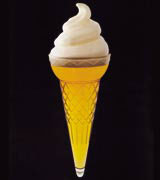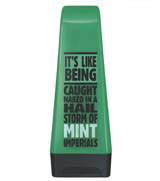Border disputes

Advertising and packaging design often overlap, but is it effective marketing and where do the boundaries lie? Top practitioners from both sides of the divide tell Kerstin Kühn where the line should be drawn
Packaging and advertising have a long, shared history. Indeed, advertising, in a sense, started with packaging, as many of the first ads were simply pictures or logos of the products they were about. Packaging, in a similar sense, is advertising, as it comprises the ad in the shop – the ad we take home with us.
Garrick Hamm, creative director at Williams Murray Hamm, suggests that, although packaging isn’t advertising, divisions between the two are starting to blur again. The role of packaging, he argues, has increasingly become that of the ad on the shelf, and it must send out a strong message to the consumer. ‘Where packaging often used to comprise only a logo, today this isn’t enough,’ says Hamm. ‘With more and more products shouting from the shelf, packaging needs to be captivating and send out a strong message.’
He suggests that a lot of design consultancies are starting to play this game, with a move towards more engaging packaging design. ‘Advertising, in its very essence, aims to engage consumers and so, with packaging increasingly using the art of engagement, the two are becoming closer,’ says Hamm.
Not surprisingly, this is a position that has support from across the fence. Russell Ramsey, deputy executive creative director at advertising agency Bartle Bogle Hegarty, says, ‘Design and advertising need to work closer together. [Packaging] needs to be designed to work on billboards and in TV commercials, not just on the shelf.’ He says that Boddingtons press advertising, inspired by its pack design, is a good example of how the communication can reflect the packaging, without the need for a pack shot.
Luke Williamson, creative director at advertising agency WCRS, says, sadly, he doesn’t often get to work as closely with designers as he did in the past. But he believes clients should be taking a much more holistic view, and that creatives shouldn’t be precious about where the ideas originate. ‘As far as ideas are concerned, they should come from anywhere and anyone. As long as they are right for the brand, it doesn’t matter. Our job is to bring it all to life,’ he says.
Nevertheless, there are those who believe there is a fundamental difference between advertising and packaging. Beth Barry, planning director at Coley Porter Bell, explains that, while advertising is a frequently changing medium, packaging is much more constant. ‘Advertising campaigns are often short-lived, but packaging rarely changes as much. Because of its permanence, packaging, more than anything, is what consumers identify a product with, and it is therefore the most powerful tool of brand communication,’ she says.
Andy Knowles, creative director of Jones Knowles Ritchie, agrees and argues that the primary role of packaging is to help consumers recognise a brand from a distance. He feels that by incorporating advertising into the packaging design, it becomes too complicated and thus ineffective.
‘Branding must be single-minded and you can not say too much through packaging. If you do, you undermine the brand. In my experience, packaging design that takes on too much of an advertising role usually doesn’t last long,’ he says.
Knowles cites WMH’s adventurous (and since redesigned) Jaffa Cakes packaging as an example. ‘The creatives at Williams Murray Hamm are the pioneers of bold packaging design, which incorporates advertising. Although the Jaffa Cakes packaging was groundbreaking and award-winning, its boldness quickly proved too much, which was probably why McVities decided to axe it,’ he says.

Alongside a move towards bolder packaging design, the world of advertising has become ever more fragmented. Advertising has begun to use more and more channels of communication, incorporating media such as the Internet, TV and even mobile phones. This fragmentation, Knowles points out, makes successful advertising increasingly expensive for clients and brings packaging into the frame. ‘Packaging is a cheaper medium and, as a result, clients are starting to use packaging as advertising,’ says Knowles. ‘But this destroys the ability to create a unique identity for a brand, as it creates barriers for the packaging to remain constant. The two must play separate roles.’
Even if, as Knowles argues, packaging and advertising must each do their own job, they clearly also need to work together. For many designers and advertising creatives, achieving harmony is the most important aspect of the marriage between the two media.
But, of course, design consultancies and advertising agencies don’t always work well together. According to Hamm, a lack of communication between the two can lead to inconsistencies in the work. He suggests design consultancies and advertising agencies should not merely be briefed together, but continue to share their ideas throughout the creative process. ‘If, after being briefed together, you go off for a few months and work separately on your ideas, often when you come together at the end, despite the same brief, the ideas are so different that they don’t fit together,’ he says.
Hamm says the advertising campaign of a brand must be in visual harmony with the packaging and sympathetic with the brand position. ‘The two media must be used alongside each other to do the right thing for the brand. And the right thing is a smooth transition between the two.’ He points to O2 as an example of a brand that shows complete harmony between its design and advertising by Lambie-Nairn and VCCP respectively (who incidentally share the same premises). ‘What Lambie-Nairn has done with the O2 brand is extraordinary. It’s not often there is such a seamless transition between design and advertising. This to me translates as full control of the brand,’ he says.
The blurred dividing line, and the sophistication of consumers’ understanding of the games that brands play, is amply demonstrated by personal care range Original Source. Coming full circle, its press advertising (by BDH/TBWA) depicts the shower gel carrying a WMH-type slogan, even though the actual products on sale (designed by Alloy, with graphics by The Chase) do without. l
-
Post a comment




